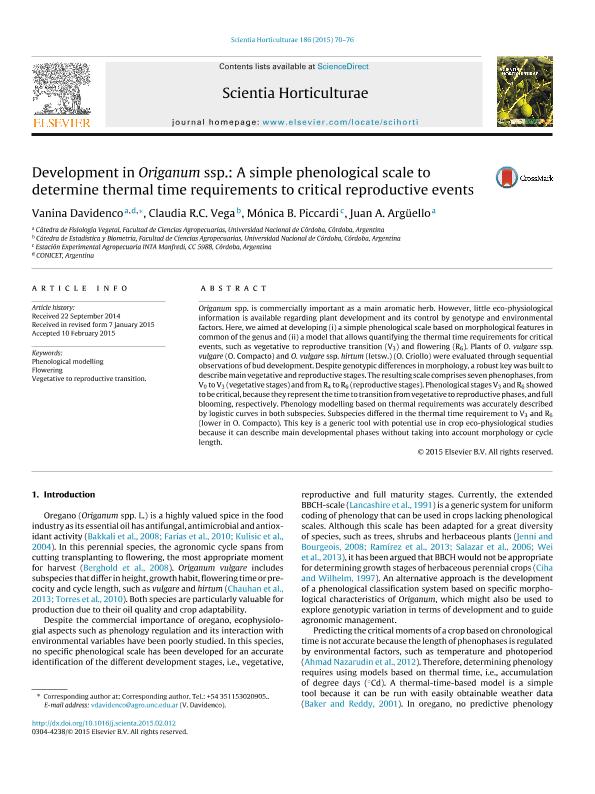Mostrar el registro sencillo del ítem
dc.contributor.author
Davidenco, Vanina

dc.contributor.author
Vega, Claudia Rosa Cecilia

dc.contributor.author
Piccardi, Mónica Belén

dc.contributor.author
Arguello, Juan Alberto

dc.date.available
2018-03-02T20:27:19Z
dc.date.issued
2015-04
dc.identifier.citation
Davidenco, Vanina; Vega, Claudia Rosa Cecilia; Piccardi, Mónica Belén; Arguello, Juan Alberto; Development in Origanum ssp.: A simple phenological scale to determine thermal time requirements to critical reproductive events; Elsevier Science; Scientia Horticulturae; 186; 4-2015; 70-76
dc.identifier.issn
0304-4238
dc.identifier.uri
http://hdl.handle.net/11336/37743
dc.description.abstract
Origanum spp. is commercially important as a main aromatic herb. However, little eco-physiological information is available regarding plant development and its control by genotype and environmental factors. Here, we aimed at developing (i) a simple phenological scale based on morphological features in common of the genus and (ii) a model that allows quantifying the thermal time requirements for critical events, such as vegetative to reproductive transition (V3) and flowering (R6). Plants of O. vulgare ssp. vulgare (O. Compacto) and O. vulgare ssp. hirtum (Ietsw.) (O. Criollo) were evaluated through sequential observations of bud development. Despite genotypic differences in morphology, a robust key was built to describe main vegetative and reproductive stages. The resulting scale comprises seven phenophases, from V0 to V3 (vegetative stages) and from R4 to R6 (reproductive stages). Phenological stages V3 and R6 showed to be critical, because they represent the time to transition from vegetative to reproductive phases, and full blooming, respectively. Phenology modelling based on thermal requirements was accurately described by logistic curves in both subspecies. Subspecies differed in the thermal time requirement to V3 and R6 (lower in O. Compacto). This key is a generic tool with potential use in crop eco-physiological studies because it can describe main developmental phases without taking into account morphology or cycle length.
dc.format
application/pdf
dc.language.iso
eng
dc.publisher
Elsevier Science

dc.rights
info:eu-repo/semantics/openAccess
dc.rights.uri
https://creativecommons.org/licenses/by-nc-nd/2.5/ar/
dc.subject
Flowering
dc.subject
Phenological Modelling
dc.subject
Vegetative to Reproductive Transition
dc.subject.classification
Agricultura

dc.subject.classification
Agricultura, Silvicultura y Pesca

dc.subject.classification
CIENCIAS AGRÍCOLAS

dc.title
Development in Origanum ssp.: A simple phenological scale to determine thermal time requirements to critical reproductive events
dc.type
info:eu-repo/semantics/article
dc.type
info:ar-repo/semantics/artículo
dc.type
info:eu-repo/semantics/publishedVersion
dc.date.updated
2018-03-02T14:08:30Z
dc.journal.volume
186
dc.journal.pagination
70-76
dc.journal.pais
Países Bajos

dc.journal.ciudad
Amsterdam
dc.description.fil
Fil: Davidenco, Vanina. Universidad Nacional de Córdoba. Facultad de Ciencias Agropecuarias. Cátedra de Fisiología Vegetal; Argentina. Consejo Nacional de Investigaciones Científicas y Técnicas; Argentina
dc.description.fil
Fil: Vega, Claudia Rosa Cecilia. Universidad Nacional de Córdoba. Facultad de Ciencias Agropecuarias; Argentina. Consejo Nacional de Investigaciones Científicas y Técnicas; Argentina
dc.description.fil
Fil: Piccardi, Mónica Belén. Instituto Nacional de Tecnología Agropecuaria. Centro Regional Córdoba. Estación Experimental Agropecuaria Manfredi; Argentina. Consejo Nacional de Investigaciones Científicas y Técnicas; Argentina
dc.description.fil
Fil: Arguello, Juan Alberto. Universidad Nacional de Córdoba. Facultad de Ciencias Agropecuarias. Cátedra de Fisiología Vegetal; Argentina
dc.journal.title
Scientia Horticulturae

dc.relation.alternativeid
info:eu-repo/semantics/altIdentifier/doi/http://dx.doi.org/10.1016/j.scienta.2015.02.012
dc.relation.alternativeid
info:eu-repo/semantics/altIdentifier/url/https://www.sciencedirect.com/science/article/pii/S0304423815000710
Archivos asociados
